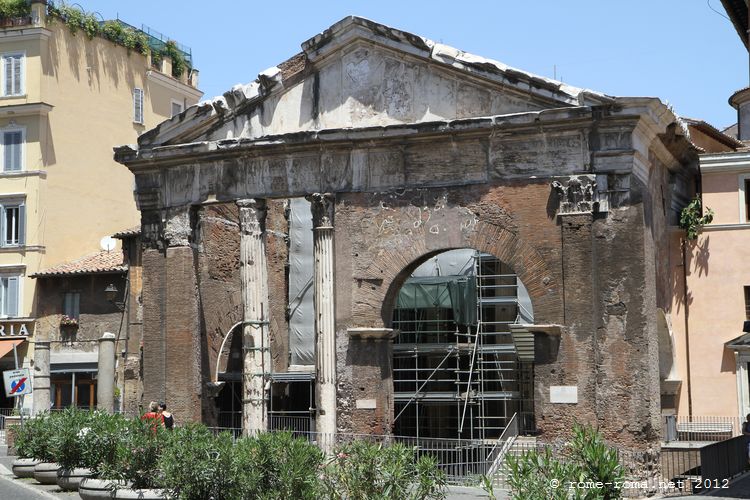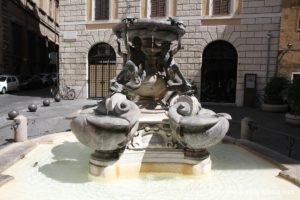Rione Sant’Angelo and the Ghetto
The Rione Sant’Angelo, one of Rome’s historic districts, stretches between Largo di Torre Argentina Square with its ancient sanctuary, the Tiber Island, and the Theatre of Marcellus. It also included the Theatre of Balbus and the Circus Flaminius.
But this area is above all marked by Rome’s historic ghetto, of which few traces of the old urban layout remain, when it was unhealthy, characterized by narrow alleys, tall houses often damaged by floods of the Tiber. Most of them were demolished during the redevelopment of the late 19th century, which transformed the area into a more open quarter, pleasant in summer and with a village-like atmosphere at the heart of the city.
Today, the term ghetto refers to a larger area than that once enclosed by the walls of the historic ghetto, demolished in the 19th century. It corresponds to the space between Via Arenula to the west, then Via dei Falegnami and Via dei Funari to the east, Via della Tribuna di Campitelli and Via del Portico d’Ottavia to the south, and finally the Lungotevere de’ Cenci running along the Tiber.
Jewish Heritage and Culture
Despite the major transformations of the 19th century, the district has preserved the imprint of the centuries during which Jews were confined there: some narrow streets, a specific Roman dialect, culinary traditions, as well as the Great Synagogue and a still very active community.
As for gastronomy, one finds fish soup linked to the nearby former fish market, fried artichokes, or delicious pastries such as Pizza Ebraica.
Heritage and curiosities of the district
In Rione Sant’Angelo are found several palaces and small squares where one can perceive more of a medieval character than in other areas of Rome, such as Piazza Mattei with the Turtle Fountain or the Palazzo Mattei di Giove.
There are no grand buildings apart from the Portico of Octavia and the Theatre of Marcellus, but many curiosities can be discovered while walking through its alleys, along with a few churches and some remains such as those of the Temple of Apollo Sosianus.
→ See also the itineraries in the Roman Ghetto.
The historic ghetto
Jews have been settled in Rome since the Roman Republic of antiquity, first on the Aventine, then in Trastevere where they formed the majority of the population, and later in the Rione Sant’Angelo during the Middle Ages.
It was in this last district that the ghetto was enclosed by the popes. Jews were confined there for over 300 years, from 1555 to 1870, except during the short-lived Roman Republics.
This historic ghetto was enclosed by walls with gates. In the 18th century it included the area between Via del Portico d’Ottavia and the Tiber on one side, and that between the Theatre of Marcellus and Piazza delle Cinque Scole on the other. A section of the wall remains in one of the courtyards located on this latter square.
Few buildings of this former ghetto have been preserved, the churches for instance having been demolished. The houses were very tall and connected by suspended bridges, often flooded for those closest to the Tiber, poorly maintained and separated by narrow and unhealthy streets. This was due to the need to adapt to a high population density forced to live there. Most of these constructions were destroyed in the late 19th century during redevelopment.
→ Read the page on the history of the Roman Ghetto
Main monuments and sites
Museums
More sites in the district
Map of the Ghetto sites
Please add some markers to your posts before using this shortcode.





